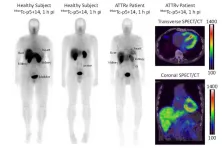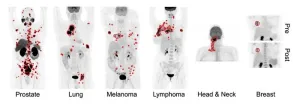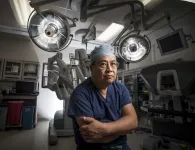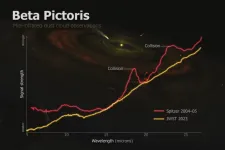(Press-News.org) University of North Carolina at Chapel Hill scientists have created innovative soft robots equipped with electronic skins and artificial muscles, allowing them to sense their surroundings and adapt their movements in real-time, according to the paper, “Skin-Inspired, Sensory Robots for Electronic Implants,” in Nature Communications.
In their research, funded by the National Science Foundation and the National Institutes of Health, the robots are designed to mimic the way muscles and skin work together in animals, making them more effective and safer to use inside the body. The e-skin integrates various sensing materials, such as silver nanowires and conductive polymers within a flexible base, closely resembling the complex sensory functions of real skin.
“These soft robots can perform a variety of well-controlled movements, including bending, expanding and twisting inside biological environments,” said Lin Zhang, first author of the paper and a postdoctoral fellow in Carolina’s Department of Applied Physical Sciences. “They are designed to attach to tissues gently, reducing stress and potential damage. Inspired by natural shapes like starfish and seedpods, they can transform their structures to perform different tasks efficiently.”
These features make soft sensory robots highly adaptable and useful for enhancing medical diagnostics and treatments. They can change shape to fit organs for better sensing and treatment; are capable of continuous monitoring of internal conditions, like bladder volume and blood pressure; provide treatments, such as electrical stimulation, based on real-time data; and can be swallowed to monitor and treat conditions in the stomach.
An ingestible robot capable of residing in the stomach called a thera-gripper, can monitor pH levels and deliver drugs over an extended period, improving treatment outcomes for gastrointestinal conditions. The thera-gripper can also gently attach to a beating heart, continuously monitoring electrophysiological activity, measuring cardiac contraction and providing electrical stimulation to regulate heart rhythm.
A robotic gripper designed to wrap around a person’s bladder can measure its volume and provide electrical stimulation to treat the overactive one, enhancing patient care and treatment efficacy. A robotic cuff that twists around a blood vessel can accurately measure blood pressure in real time, offering a non-invasive and precise monitoring solution.
“Tests on mice have demonstrated the thera-gripper’s capability to perform these functions effectively, showcasing its potential as a next-generation cardiac implant,” said Zhang.
The Bai Lab collaborated on the study with UNC-Chapel Hill researchers in the Department of Biology; Department of Biomedical Engineering; Department of Chemistry; Joint Department of Biomedical Engineering and McAllister Heart Institute; North Carolina State University; and Weldon School of Biomedical Engineering at Purdue University.
The researchers’ success in live animal models suggests a promising future for these robots in real-world medical applications, potentially revolutionizing the treatment of chronic diseases and improving patient outcomes.
“This innovative approach to robot design not only broadens the scope of medical devices but also highlights the potential for future advancements in the synergistic interaction between soft implantable robots and biological tissues,” said Wubin Bai, principal investigator of the research and Carolina assistant professor. “We’re aiming for long-term biocompatibility and stability in dynamic physiological environments.”
END
UNC-Chapel Hill researchers create skin-inspired sensory robots to provide medical treatment
2024-06-10
ELSE PRESS RELEASES FROM THIS DATE:
Researchers use 3D visualization to predict, prevent hurricane damage
2024-06-10
Beginning annually on June 1, hurricane season poses a major threat to Texas coastal communities, causing both physical and financial damage to the areas they hit. This damage can be staggering; when Hurricane Harvey hit in 2017, it cost Galveston $132.73 billion in damages. Texas A&M University researchers have collaborated to understand the impacts of storm surge floods before they occur to potentially reduce the level of damage. Their study was published in “Urban Informatics.”
The researchers have implemented 3D visualization technology to identify the potential outcomes of hurricane flooding ...
Kepplinger, Vidyashankar to receive funding for conference
2024-06-10
David Kepplinger, Assistant Professor, Statistics, and Anand Vidyashankar, Professor, Statistics, are set to receive funding from the National Science Foundation for: “Conference: Building a robust community: Joint International Conference on Robust Statistics and Conference on Data Science, Statistics, and Data Science.”
Kepplinger and Vidyashankar will receive $20,993 from NSF for this award. Funding will begin in July 2024 and will end in late June 2025.
The funding will support 15–20 students and early-career researchers to participate in the joint International Conference on Robust Statistics (ICORS) and the Conference ...
Novel radiotracer produces high quality images of “Alzheimer’s disease of the heart”
2024-06-10
Toronto, Ontario—A newly developed radiotracer can generate high quality and readily interpretable images of cardiac amyloidosis, a condition referred to as the “Alzheimer’s disease of the heart.” As the first amyloid-specific and pan-amyloid binding radiotracer designed for planar and SPECT/CT imaging, 99mTc-p5+14 could play an important role in early detection and treatment of cardiac amyloidosis. This research was presented at the 2024 Society of Nuclear Medicine and Molecular Imaging Annual Meeting.
Systemic amyloidosis is an incurable disease in which abnormal amounts of ...
New AI tool accurately detects six different cancer types on whole-body PET/CT scans
2024-06-10
Toronto, Ontario—A novel AI approach can accurately detect six different types of cancer on whole-body PET/CT scans, according to research presented at the 2024 Society of Nuclear Medicine and Molecular Imaging Annual Meeting. By automatically quantifying tumor burden, the new tool can be useful for assessing patient risk, predicting treatment response, and estimating survival.
“Automatic detection and characterization of cancer are important clinical needs to enable early treatment,” said Kevin H. ...
Galactic bloodlines: Many nearby star clusters originate from only three "families"
2024-06-10
An international team of astronomers led by the University of Vienna has deciphered the formation history of young star clusters, some of which we can see with the naked eye at night. The team, led by Cameren Swiggum and João Alves from the University of Vienna and Robert Benjamin from the University of Wisconsin-Whitewater, reports that most nearby young star clusters belong to only three families, which originate from very massive star-forming regions. This research also provides new insights into the effects of supernovae (violent explosions at the end of the life ...
New City of Hope study shows liver surgery to remove cancer can now be a safe, outpatient procedure
2024-06-10
LOS ANGELES — A new study guided by a renowned surgeon at City of Hope®, one of the largest cancer research and treatment organizations in the United States, demonstrates that robotic liver surgery can be a safe, outpatient procedure. In fact, 8% of the patients sampled in the analysis were discharged to go home on the same day.
“We have made so much progress in liver cancer. We can now deliver more cures and use less invasive treatment options. This study is proof that for the right patients and with the right tools — meaning robotic surgery — we can get people through a liver operation quicker and toward recovery and normal ...
For type 1 diabetes distress, focus first on managing emotions
2024-06-10
FOR IMMEDIATE RELEASE
Media Contact: Jess Berthold (628) 399-0432
Jess.Berthold@ucsf.edu
Subscribe to UCSF News
For Type 1 Diabetes Distress, Focus First on Managing Emotions
Virtual, emotion-centered program cuts distress in half after one year, while also improving patients’ glucose control.
The most effective way to reduce the distress that comes with having diabetes – and improve glucose control – is to focus on managing the emotional strain of living with the condition, a new study of adults that was led by researchers at UC San Francisco has found.
Diabetes distress, or DD, refers to ...
Webb telescope reveals asteroid collision in neighboring star system
2024-06-10
Astronomers have captured what appears to be a snapshot of a massive collision of giant asteroids in Beta Pictoris, a neighboring star system known for its early age and tumultuous planet-forming activity.
The observations spotlight the volatile processes that shape star systems like our own, offering a unique glimpse into the primordial stages of planetary formation.
“Beta Pictoris is at an age when planet formation in the terrestrial planet zone is still ongoing through giant asteroid collisions, so what we could be seeing here is basically how rocky planets and other bodies are forming in real time,” said Christine Chen, a Johns Hopkins University astronomer ...
When is genome sequencing advisable?
2024-06-10
Genetic mutations in human DNA can prevent proteins that perform important functions in the body from being formed correctly. This can lead to serious disorders that cause disease or even disability. Many of these diseases are already known and can be attributed to specific genes. To diagnose them, clinicians use a standard procedure known as exome sequencing. This involves analysing those segments of human DNA that are directly responsible for the correct formation of proteins. This coding part, the exome, makes up only around ...
Association found between media diet and science-consistent beliefs about climate change
2024-06-10
In a paper titled “The Politicization of Climate Science: Media Consumption, Perceptions of Science and Scientists, and Support for Policy,” published May 26, 2024, in the Journal of Health Communication, researchers probed the associations between media exposure and science-consistent beliefs about climate change and the threat it posed to the respondent.
Expanding on earlier work associating Fox News consumption with doubts about the existence of human-caused climate change, a team of scholars affiliated with the Annenberg Public Policy ...





